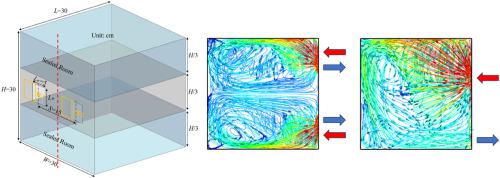当前位置:
X-MOL 学术
›
Build. Environ.
›
论文详情
Our official English website, www.x-mol.net, welcomes your feedback! (Note: you will need to create a separate account there.)
CFD simulation of pumping ventilation with two asymmetrically arranged openings on the rear wall in a three-story isolated building
Building and Environment ( IF 7.4 ) Pub Date : 2024-04-03 , DOI: 10.1016/j.buildenv.2024.111486 Huai-Yu Zhong , Jie Sun , Chao Lin , Hideki Kikumoto , Wei Dong , Yang Cai , Fu-Yun Zhao , Song-Heng Wu , Fu-Ping Qian
Building and Environment ( IF 7.4 ) Pub Date : 2024-04-03 , DOI: 10.1016/j.buildenv.2024.111486 Huai-Yu Zhong , Jie Sun , Chao Lin , Hideki Kikumoto , Wei Dong , Yang Cai , Fu-Yun Zhao , Song-Heng Wu , Fu-Ping Qian

|
Pumping ventilation, driven by periodic vortex shedding, can effectively improve the ventilation rate of single-sided ventilation. Previous studies on pumping ventilation mainly considered symmetric opening conditions, while the asymmetric opening distribution has not been well studied. Therefore, this study investigates the pumping ventilation of an isolated three-story building with asymmetric opening conditions using computational fluid dynamics (CFD) simulations. Unsteady Reynolds-averaged Navier-Stokes (URANS) method with SST - turbulent model is adopted to conduct the CFD simulations. The effects of horizontal translation distances, internal partitions, and inter-floor interference on time-averaged and fluctuating ventilation rates are investigated. The simulation results show that the mean ventilation rate is larger than the fluctuating ventilation rate. The mean ventilation rate increases while the fluctuating ventilation rate decreases with the increase of the horizontal translation distance. In addition, the internal partition decreases the pumping ventilation rate primarily by reducing the fluctuating ventilation rate rather than the mean ventilation rate. Furthermore, the ventilation rates of the 2nd floor are promoted by simultaneous pumping ventilation of the 1st and 3rd floors compared to the situation that only the 2nd floor is ventilated. The ventilation rates of the 1st floor are the largest, and of the 3rd floor are the lowest. The findings of this study benefit the deeper understanding of pumping ventilation and provide theoretical guidance on the opening designs of multi-story buildings for better ventilation efficiency.
中文翻译:

三层隔离建筑后墙上两个不对称开口的泵送通风的 CFD 模拟
泵送通风,通过周期性涡流脱落驱动,可以有效提高单面通风的通风率。以往的抽水通风研究主要考虑对称开口条件,而对非对称开口分布的研究还不够深入。因此,本研究利用计算流体动力学 (CFD) 模拟研究了具有不对称开口条件的独立三层建筑的抽水通风。采用 SST 湍流模型的非稳态雷诺平均纳维斯托克斯 (URANS) 方法进行 CFD 模拟。研究了水平平移距离、内部隔断和楼层间干扰对时间平均通风率和波动通风率的影响。模拟结果表明,平均通风量大于波动通风量。随着水平平移距离的增加,平均通风量增大,波动通风量减小。此外,内部隔板主要通过降低波动通风率而不是平均通风率来降低泵送通风率。此外,与仅二楼通风的情况相比,一楼和三楼同时泵送通风提高了二楼的通风率。一楼通风量最大,三楼通风量最低。本研究的结果有助于加深对抽水通风的认识,并为多层建筑的开口设计提高通风效率提供理论指导。
更新日期:2024-04-03
中文翻译:

三层隔离建筑后墙上两个不对称开口的泵送通风的 CFD 模拟
泵送通风,通过周期性涡流脱落驱动,可以有效提高单面通风的通风率。以往的抽水通风研究主要考虑对称开口条件,而对非对称开口分布的研究还不够深入。因此,本研究利用计算流体动力学 (CFD) 模拟研究了具有不对称开口条件的独立三层建筑的抽水通风。采用 SST 湍流模型的非稳态雷诺平均纳维斯托克斯 (URANS) 方法进行 CFD 模拟。研究了水平平移距离、内部隔断和楼层间干扰对时间平均通风率和波动通风率的影响。模拟结果表明,平均通风量大于波动通风量。随着水平平移距离的增加,平均通风量增大,波动通风量减小。此外,内部隔板主要通过降低波动通风率而不是平均通风率来降低泵送通风率。此外,与仅二楼通风的情况相比,一楼和三楼同时泵送通风提高了二楼的通风率。一楼通风量最大,三楼通风量最低。本研究的结果有助于加深对抽水通风的认识,并为多层建筑的开口设计提高通风效率提供理论指导。



























 京公网安备 11010802027423号
京公网安备 11010802027423号